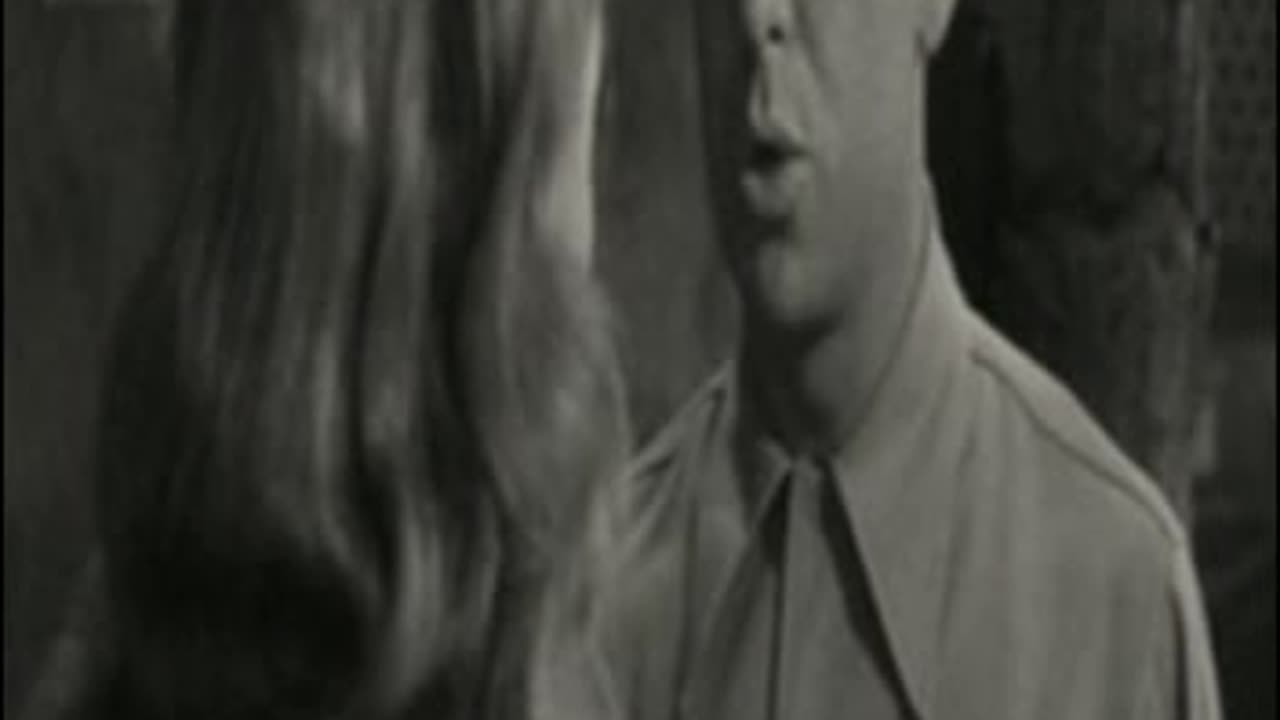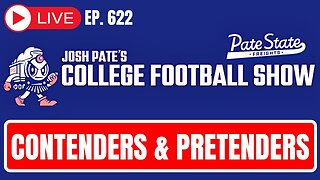Premium Only Content

Old Hollywood Bloopers (1942)
Classical Hollywood cinema, or the Golden Age of Hollywood, is defined as a technical and narrative style characteristic of American cinema from 1913 to 1969, during which thousands of movies were issued from the Hollywood studios. The Classical style began to emerge in 1913, was accelerated in 1917 after the U.S. entered World War I, and finally solidified when the film The Jazz Singer was released in 1927, ending the silent film era and increasing box-office profits for film industry by introducing sound to feature films.
Most Hollywood pictures adhered closely to a formula – Western, Slapstick Comedy, Musical, Animated Cartoon, Biographical Film (biographical picture) – and the same creative teams often worked on films made by the same studio. For example, Cedric Gibbons and Herbert Stothart always worked on MGM films, Alfred Newman worked at 20th Century Fox for twenty years, Cecil B. De Mille's films were almost all made at Paramount, and director Henry King's films were mostly made for 20th Century Fox.
At the same time, one could usually guess which studio made which film, largely because of the actors who appeared in it; MGM, for example, claimed it had contracted "more stars than there are in heaven." Each studio had its own style and characteristic touches which made it possible to know this – a trait that rarely exist today.
For example, To Have and Have Not (1944) is notable not only for the first pairing of actors Humphrey Bogart (1899–1957) and Lauren Bacall (1924–2014), but because it was written by two future winners of the Nobel Prize in Literature: Ernest Hemingway (1899–1961), the author of the novel on which the script was nominally based, and William Faulkner (1897–1962), who worked on the screen adaptation.
After The Jazz Singer was released in 1927, Warner Bros. gained huge success and were able to acquire their own string of movie theaters, after purchasing Stanley Theaters and First National Productions in 1928. In contrast Loews theaters owned MGM since forming in 1924, while the Fox Film Corporation owned the Fox Theatre. RKO (a 1928 merger between Keith-Orpheum Theaters and the Radio Corporation of America[35]) also responded to the Western Electric/ERPI monopoly over sound in films, and developed their own method, known as Photophone, to put sound in films.[32]
Paramount, which acquired Balaban and Katz in 1926, would answer to the success of Warner Bros. and RKO, and buy a number of theaters in the late 1920s as well, and would hold a monopoly on theaters in Detroit, Michigan.[36] By the 1930s, almost all of the first-run metropolitan theaters in the United States were owned by the Big Five studios—MGM, Paramount Pictures, RKO, Warner Bros., and 20th Century Fox.[37]
1927–1948: Rise and decline of the studio system
Hollywood movie studios, 1922
Motion picture companies operated under the studio system. The major studios kept thousands of people on salary—actors, producers, directors, writers, stunt men, crafts persons, and technicians. They owned or leased Movie Ranches in rural Southern California for location shooting of westerns and other large-scale genre films, and the major studios owned hundreds of theaters in cities and towns across the nation in 1920 film theaters that showed their films and that were always in need of fresh material.
Spencer Tracy was the first actor to win Best Actor award over two consecutive years for his roles in Captains Courageous (1937) and Boys Town (1938) (and received seven other nominations).
In 1930, MPPDA President Will Hays created the Hays (Production) Code, which followed censorship guidelines and went into effect after government threats of censorship expanded by 1930.[38] However, the code was never enforced until 1934, after the Catholic watchdog organization The Legion of Decency—appalled by some of the provocative films and lurid advertising of the era later classified Pre-Code Hollywood- threatened a boycott of motion pictures if it did not go into effect.[39] The films that did not obtain a seal of approval from the Production Code Administration had to pay a $25,000 fine and could not profit in the theaters, as the MPPDA controlled every theater in the country through the Big Five studios.
Throughout the 1930s, as well as most of the golden age, MGM dominated the film screen and had the top stars in Hollywood, and they were also credited for creating the Hollywood star system altogether.[40] Some MGM stars included "King of Hollywood" Clark Gable, Lionel Barrymore, Jean Harlow, Norma Shearer, Greta Garbo, Joan Crawford, Jeanette MacDonald, Gene Raymond, Spencer Tracy, Judy Garland, and Gene Kelly.[40] But MGM did not stand alone.
Another great achievement of US cinema during this era came through Walt Disney's animation company. In 1937, Disney created the most successful film of its time, Snow White and the Seven Dwarfs.[41] This distinction was promptly topped in 1939 when Selznick International created what is still, when adjusted for inflation, the most successful film of all time in Gone with the Wind.[42]
Many film historians have remarked upon the many great works of cinema that emerged from this period of highly regimented filmmaking. One reason this was possible is that, with so many movies being made, not every one had to be a big hit. A studio could gamble on a medium-budget feature with a good script and relatively unknown actors: Citizen Kane, directed by Orson Welles (1915–1985) and often regarded as the greatest film of all time, fits this description. In other cases, strong-willed directors like Howard Hawks (1896–1977), Alfred Hitchcock (1899–1980), and Frank Capra (1897–1991) battled the studios in order to achieve their artistic visions.
The apogee of the studio system may have been the year 1939, which saw the release of such classics as The Wizard of Oz, Gone with the Wind, Stagecoach, Mr. Smith Goes to Washington, Wuthering Heights, Only Angels Have Wings, Ninotchka and Midnight. Among the other films from the Golden Age period that are now considered to be classics: Casablanca, It's a Wonderful Life, It Happened One Night, the original King Kong, Mutiny on the Bounty, Top Hat, City Lights, Red River, The Lady from Shanghai, Rear Window, On the Waterfront, Rebel Without a Cause, Some Like It Hot, and The Manchurian Candidate.
Percentage of the US population that went to the cinema on average, weekly, 1930–2000
Walt Disney introduces each of the seven dwarfs in a scene from the original 1937 Snow White movie trailer.
The studio system and the Golden Age of Hollywood succumbed to two forces that developed in the late 1940s:
a federal antitrust action that separated the production of films from their exhibition; and
the advent of television.
In 1938, Walt Disney's Snow White and the Seven Dwarfs was released during a run of lackluster films from the major studios, and quickly became the highest grossing film released to that point. Embarrassingly for the studios, it was an independently produced animated film that did not feature any studio-employed stars.[43] This stoked already widespread frustration at the practice of block-booking, in which studios would only sell an entire year's schedule of films at a time to theaters and use the lock-in to cover for releases of mediocre quality.
Assistant Attorney General Thurman Arnold—a noted "trust buster" of the Roosevelt administration—took this opportunity to initiate proceedings against the eight largest Hollywood studios in July 1938 for violations of the Sherman Antitrust Act.[44][45] The federal suit resulted in five of the eight studios (the "Big Five": Warner Bros., MGM, Fox, RKO and Paramount) reaching a compromise with Arnold in October 1940 and signing a consent decree agreeing to, within three years:
Eliminate the block-booking of short film subjects, in an arrangement known as "one shot", or "full force" block-booking.
Eliminate the block-booking of any more than five features in their theaters.
No longer engage in blind buying (or the buying of films by theater districts without seeing films beforehand) and instead have trade-showing, in which all 31 theater districts in the US would see films every two weeks before showing movies in theaters.
Set up an administration board in each theater district to enforce these requirements.[44]
The "Little Three" (Universal Studios, United Artists, and Columbia Pictures), who did not own any theaters, refused to participate in the consent decree.[44][45] A number of independent film producers were also unhappy with the compromise and formed a union known as the Society of Independent Motion Picture Producers and sued Paramount for the monopoly they still had over the Detroit Theaters—as Paramount was also gaining dominance through actors like Bob Hope, Paulette Goddard, Veronica Lake, Betty Hutton, crooner Bing Crosby, Alan Ladd, and longtime actor for studio Gary Cooper too- by 1942. The Big Five studios did not meet the requirements of the Consent of Decree during WWII, without major consequence, but after the war ended they joined Paramount as defendants in the Hollywood antitrust case, as did the Little Three studios.[46]
The Supreme Court eventually ruled that the major studios ownership of theaters and film distribution was a violation of the Sherman Antitrust Act. As a result, the studios began to release actors and technical staff from their contracts with the studios. This changed the paradigm of film making by the major Hollywood studios, as each could have an entirely different cast and creative team.
The decision resulted in the gradual loss of the characteristics which made Metro-Goldwyn-Mayer, Paramount Pictures, Universal Studios, Columbia Pictures, RKO Pictures, and 20th Century Fox films immediately identifiable. Certain movie people, such as Cecil B. DeMille, either remained contract artists until the end of their careers or used the same creative teams on their films so that a DeMille film still looked like one whether it was made in 1932 or 1956.
Marlon Brando with Eva Marie Saint in the trailer for On the Waterfront (1954)
Also, the number of movies being produced annually dropped as the average budget soared, marking a major change in strategy for the industry. Studios now aimed to produce entertainment that could not be offered by television: spectacular, larger-than-life productions. Studios also began to sell portions of their theatrical film libraries to other companies to sell to television. By 1949, all major film studios had given up ownership of their theaters.
This was complemented with the 1952 Miracle Decision in the Joseph Burstyn Inc. v. Wilson case, in which the Supreme Court of the United States reversed its earlier position, from 1915's Mutual Film Corporation v. Industrial Commission of Ohio case, and stated that motion pictures were a form of art and were entitled to the protection of the First amendment; US laws could no longer censor films. By 1968, with film studios becoming increasingly defiant to its censorship function, the Motion Picture Association of America (MPAA) had replaced the Hays Code–which was now greatly violated after the government threat of censorship that justified the origin of the code had ended—with the film rating system.
-
 1:07:30
1:07:30
Josh Pate's College Football Show
6 hours ago $3.53 earnedBig CFB Changes Coming | USC + Texas + Alabama In 2025 | Truth About Officiating | I Am Engaged
39.5K1 -
 4:43:40
4:43:40
Biscotti-B23
9 hours ago $1.79 earned🔴 LIVE VIEWERS VS MEMBERS BEEF 🔥 FINDING A NEW MAIN ⚔ BLEACH REBIRTH OF SOULS
28.3K2 -
 3:21:55
3:21:55
DTDUBtv
6 hours agoOUTLAST TRIALS WITH SARAHSLOTH17
26.8K -
 LIVE
LIVE
Major League Fishing
5 days agoLIVE! - MLF Bass Pro Tour: REDCREST - Day 4
5,842 watching -
 3:46:44
3:46:44
EricJohnPizzaArtist
6 hours agoAwesome Sauce PIZZA ART LIVE Ep. #42: It’s Cartman!
43.1K5 -
![[Vtuber] Black Ops 6 warzone and mp! Ep.2](https://1a-1791.com/video/fww1/68/s8/1/z/v/X/z/zvXzy.0kob-small-Vtuber-Black-Ops-6-warzone-.jpg) 5:45:29
5:45:29
Ryker SteelVT
6 hours ago[Vtuber] Black Ops 6 warzone and mp! Ep.2
13.5K2 -
 9:53
9:53
China Uncensored
10 hours agoThe UK Just Screwed Itself BADLY
26.7K14 -
 3:45:42
3:45:42
Deaf Gamer Girl
6 hours agoFortnite then Schedule 1 - DGG play !
14.4K -
 2:42:49
2:42:49
IsaiahLCarter
11 hours ago $1.55 earnedApostate Radio #008: The Healing of Adam B. Coleman
26.4K -
 17:50
17:50
Talk Nerdy Sports - The Ultimate Sports Betting Podcast
12 hours ago4/6/25: 🔥15-1 March Madness Run 🧠🔥 | MLB, NBA & PrizePicks Picks to Cook Your Bookie
93.3K8